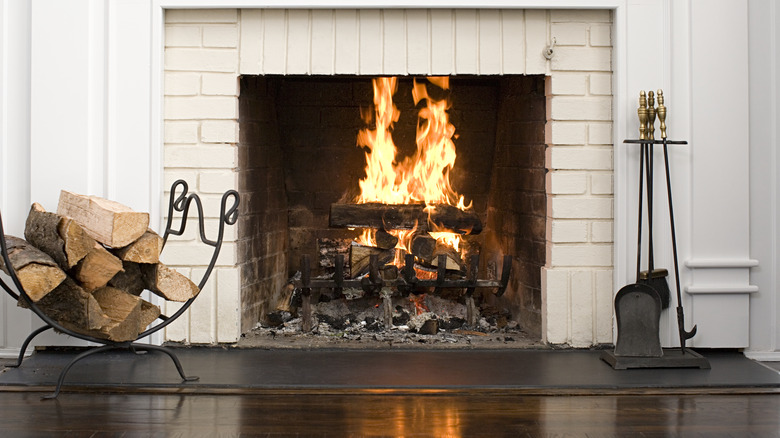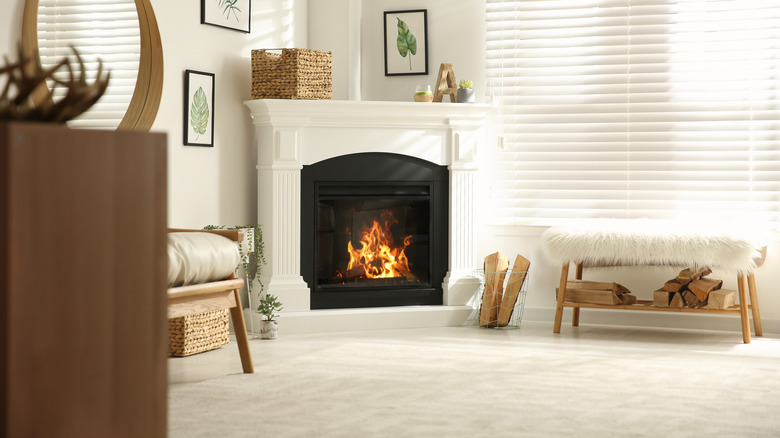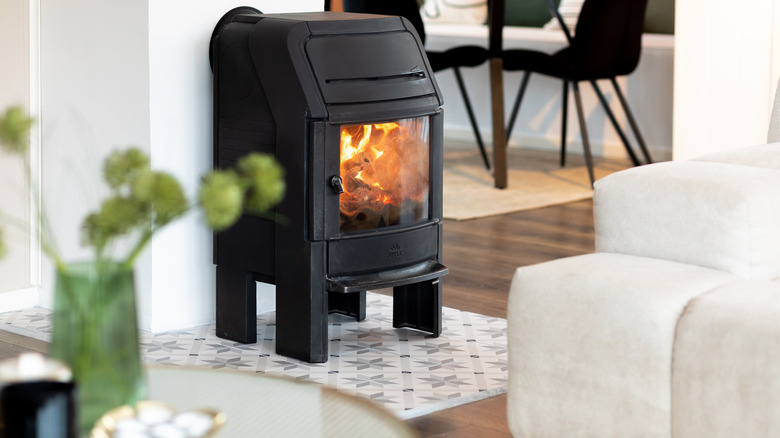Is Your Floor At Risk Of Fireplace Damage? What You Need To Know
Fireplaces are one of the most coveted architectural details in a home. According to a 2016 survey by Angi, 77% of people would gladly pay more money if a house they were buying had a fireplace. And they have good reason for doing so. Not only can it create a memorable focal point in a room, but it also creates ambiance and helps set the mood in the space. However, that doesn't mean it doesn't come with its downsides, one of which is that it can damage the floor. Specifically, your floor is at risk of fire damage if it's comprised of non-heat-resistant materials, such as laminate, carpet, and hardwood.
These materials won't be able to stand up to the constant heat and potential mess of the hearth, which means they will change in color and texture after some time. Certain kinds of laminate flooring can soften and even melt near a fireplace, wood can warp or become discolored, and carpets can stain. There are, of course, exceptions and caveats to each of these points, so if you have your heart dead set on wooden flooring near your hearth, you might still be able to pull it off. You will just need to be aware of the risks. Let's take a deeper look into what those risks are.
Why you should consider skipping laminate, hardwood, or carpeting near the fireplace
Since these materials aren't as heat-resistant as tile or stone, they're more prone to damage by constant exposure to heat, soot, and flying embers. Let's look at laminate flooring first. While it's a go-to material for many home remodels thanks to its durability, that doesn't mean it's indestructible. If you choose a low-quality laminate board, you increase its chances of becoming ruined by the fire's constant heat. The boards closest to the fireplace can eventually warp or bubble and crack, leaving behind visible damage. Hardwood is an even worse choice, as it is more susceptible to damage than laminate flooring. The floorboards nearest to the hearth can become brittle due to the constant exposure, or the finish on top can bubble and separate, creating noticeable marks. If your fireplace is old and you have been struggling with proper ventilation, more heat than normal will pump out onto the flooring, and the wood will become even more susceptible to heat damage. Plus, embers can fly out, scorching the wood.
Carpets are another iffy choice due to the fact they are the most flammable option on this list. While it's highly unlikely the carpet will spread a fire if an ember falls on it (especially since modern fibers need to extinguish quickly on their own in order to meet safety standards), they will still show a lot of potential wear. Soot can discolor the surrounding area, and smoke smells can linger in the fibers. And if an ember does fall, it can melt the spot it touched.
How to prevent damage
Luckily, if you're deadset on installing one of these floors in a room with a fireplace, you don't necessarily have to change your plans. Instead, you can make small tweaks to protect this potentially vulnerable flooring. The first is to create a tile or stone surround, which creates some space between the fire and your chosen flooring. If you already have a tile hearth, you can also consider extending it, especially if it's relatively small. A hearth remodel can span between $3 to $200 per square foot, which includes materials and labor. If you use inexpensive materials such as brick, it will be on the lower end of the spectrum, but if you use stone such as marble, you can expect to pay more.
For a cheaper option, you can also use a hearth pad. These are thick pads made from heat-resistant materials that you can put directly in front of your fireplace, like a makeshift hearth. They can be made out of everything from resin to steel to tile, depending on which brand and style you pick. There are also different pads designed for gas versus wood-burning fireplaces since wood-burning ones produce a lot more thermal heat. To use it, simply place it in front of your fireplace, creating distance between the firebox and the flooring.


